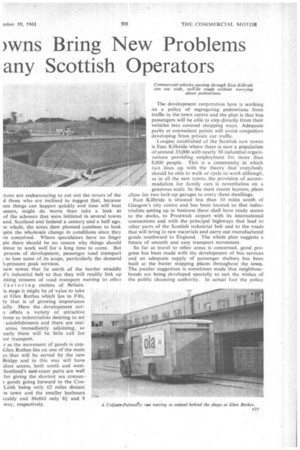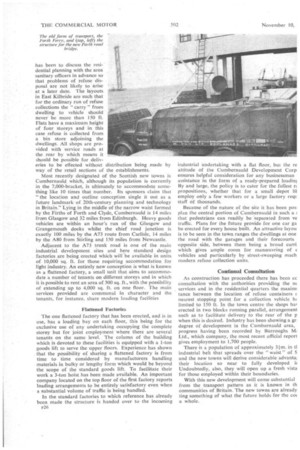The N
Page 158

Page 159

Page 160

If you've noticed an error in this article please click here to report it so we can fix it.
)wns Bring New Problems any Scottish Operators
Changes in the Pa of Transport are Brought About Scotland By a Special Correspondent
THERE was a time when the average man in Britain was glad to live near his work—but that was at a period when a much higher portion of the population was scattered over the countryside. Only about 20 per cent. of the inhabitants of Britain lived in the larger towns at the beginning of the 19th century, whereas 100 years later the proportion had risen to four-fifths. That drastic changeover ushered in an era when it was regarded as a good thing, if possible, to get away from the immediate vicinity of factories and other business establishments when work was done.
But now the new industrial areas are presenting a much more attractive face to the world and under the planning arrangements that exist today it is being made a more pleasant matter for the employee to live within walking distance of his or her work. These are changes which are altering the whole relationship of transport within the world at large. Although far-sighted men have long seen the necessity for the creation of situations in which people could have full access of urban amenities and yet be able easily to enjoy the pleasures of the countryside, it was only in 1946 that active development of new towns with this objective commenced in Britain.
Three in Scotland There are now 10 such communities in England, two in Wales and three in Scotland. Those north of the border are the now well-established East KiIbride, the newer Cumbernauld, both within the Glasgow orbit, and Glen Rothes, directly north of Edinburgh. The last-named is on the opposite side of the Forth from the Scottish capital and, like so many other communities in the area, will probably be considerably affected by the opening of the new Forth Road Bridge.
Collectively, from the transport angle, the value of the new towns is that they are planned to forestall many • of the difficulties that are now suffered by the older centres, even those like the specialist Trafford Park Industrial Estate at Manchester.
In this particular area only a few weeks ago the local manufacturers' association was compelled to initiate an inquiry into the area's traffic congestion problems. Some of these, although not all, arise from the fact that a labour force of approximately 60,000 has to be drawn in the main p24
from a 10-15-mile radius. All the workers concer limited in their travelling to only three routes, whthe 4i-sq.-mile estate to the surrounding areas, al must travel in and out by them every day.
At times serious congestion arises with goods N but more particularly the number of buses and ea: the principal roads at peak times causes a prot increasing intensity. In contrast to the Trafford Pa the new towns, if they work as visualized, will to a minimum this need for the daily use of put private transport with its peak period troubles.
Many areas which grew up during the 19th cent today suffering from the get-rich-quick methods r.1 the time of their foundation jumbled them togethei a situation that has deteriorated greatly with th growth of road transport over the past halfWithout any recourse to crystal-gazing the dew' tions are endeavouring to cut out the errors of the d those who are inclined to suggest that, because een things can happen quickly and time will beat timers, might do worse than take a look at of the schemes that were initiated in several towns and, Scotland and Ireland a century and a half ago. le whole, the areas then planned continue to look ;pite the wholesale change in conditions since they rst conceived. Where speculators have no finger pie there should be no reason why things should itinue to work well for a long time to come. But process of development, passenger road transport to lose some of its scope, particularly the demand h-pressure peak services.
• establishments and there are resiareas immediately adjoining, so early there will be little call for nir transport.
r as the movement of goods is conGlen Rothes lies on one of the main ys that will be served by the new Bridge and in this way will have diest access, both south and westScotland's east-coast ports are well for giving the shortest sea connecr goods going forward to the ConLeith being only 62 miles distant le town and the smaller harbours ccaIdy and Methil only 61 and 8 may, respectively. The development corporation here is working on a policy of segregating pedestrians from traffic in the town centre and the plan is that bus passengers will be able to step directly from their vehicles into covered shopping ways. Adequate parks at convenient points will avoid congestion developing from private car traffic.
Longest established of the Scottish new towns is East Kilbride where there is now a population of around 33,000 with nearly 50 industrial organizations providing employment for more than 8,000 people. This is a community in which fact lines up with the theory that everybody should be able to walk or cycle to work although, as in all the new towns, the provision of accommodation for family cars is nevertheless on a generous scale. In the most recent layouts, plans allow for two lock-up garages to every three dwellings.
East Kilbride is situated less than 10 miles south of Glasgow's city centre and has been located so that industrialists setting up in business there shall have ready access to the docks, to Prestwick airport with its international connections and with the principal highways that lead to other parts of the Scottish industrial belt and to the roads that will bring in raw materials and carry out manufactured goods southward to England. The whole plan suggests a future of smooth and easy transport movement So far as travel to other areas is concerned, good progress has been made with the development of bus services and an adequate supply of passenger shelters has been built at the busier stopping places throughout the town. The jocular suggestion is sometimes made that neighbourhoods are being developed specially to suit the wishes of the public cleansing authority. In actual fact the policy has been to discuss the residential planning with the area sanitary officers in advance so that problems of refuse disposal are not likely to arise at a later date. The layouts in East Kilbride are such that for the ordinary run of refuse collections the " carry " from dwelling to vehicle should never be more than 150 ft. Flats have a maximum height of four storeys and in this case refuse is collected from a bin store adjoining the dwellings. All shops are pro vided with service roads at the rear by which means it should be possible for deliveries to be effected without distribution being made by way of the retail sections of the establishments.
Most recently designated of the Scottish new towns is Cumbernauld which, although its population is currently in the 7,000-bracket, is ultimately to accommodate something like 10 times that number. Its sponsors claim that "the location and outline conception single it out as a future landmark of 20th-century planning and technology in Britain." Lying in the middle of the narrow waist formed by the Firths of Forth and Clyde, Cumbernauld is 14 miles from Glasgow and 32 miles from Edinburgh. Heavy goods vehicles are within an hour's run of the Glasgow and Grangemouth docks whilst the chief road junction is exactly 100 miles by the A73 route from Carlisle, 14 miles by the A80 from Stirling and 150 miles from Newcastle.
Adjacent to the A73 trunk road is one of the main industrial development sites and here standard design factories are being erected which will be available in units of 10,000 sq. ft. for those requiring accommodation for light industry. An entirely new conception is what is known as a flattened factory, a small unit that aims to accommodate a number of tenants on different storeys and in which it is possible to rent an area of 300 sq. ft., with the possibility of extending up to 4,000 sq. ft. on one floor. The main services provided are communal in character and the tenants, for instance, share modern loading facilities Flattened Factories The one flattened factory that has been erected, and is in use, has a loading bay on each floor, this being for the exclusive use of any undertaking occupying the complete storey but for joint employment where there are several tenants on the same level. The column of the building which is devoted to these facilities is equipped with a 1-ton goods lift to serve the upper floors. Experience has shown that the possibility of sharing a flattened factory is from time to time considered by manufacturers handling materials in bulky or lengthy form which would be beyond the scope of the standard goods lift. To facilitate their work a 3-ton hoist has been made available. An important company located on the top floor of the first factory reports loading arrangements to be entirely satisfactory even when a substantial volume of traffic is being handled.
In the standard factories to which reference has already been made the structure is handed over to the incoming F26 industrial undertaking with a flat floor, but the re attitude of the Cumbernauld Development Corp ensures helpful consideration for any businessman assistance in the form of a ready-prepared loadim By and large, the policy is to cater for the fullest rk• propositions, whether that for a small depot lil employ only a few workers or a large factory requ staff of thousands.
Because of the nature of the site it has been post plan the central portion of Cumbernauld in such a that pedestrians can readily be 'separated from ye traffic. Plans for the future provide for one car ga be erected for every house built. An attractive layou is to be seen in the town ranges the dwellings at one the road with the garages and their forecourts opposite side, between them being a broad carri which gives ample room for manoeuvring of vehicles and particularly by street-sweeping mach modern refuse collection units.
Continual Consultation As construction has proceeded there has been cc consultation with the authorities providing the rif services and in the residential quarters the maxim tance between the location of refuse containers E nearest stopping point for a collection vehicle 1-tlimited to 150 ft. In the town centre the shops hal erected in two blocks running parallel, arrangement such as to facilitate delivery to the rear of the p when this is desired. Industry has been showing a gr. degree of development in the Cumbernauld area, progress having been recorded by Burroughs M; Ltd., which company, the most recent official report gives employment to 1,700 people.
There is a population of approximately 34m. in ti industrial belt that spreads over the " waist " of S and the new towns will derive considerable advantal their location so near to fully developed it Undoubtedly, also, they will open up a fresh vista for those employed within their boundaries.
With this new development will come substantial from the transport pattern as it is known in th communities of Britain. The new towns are already ting something of what the future holds for the cot a whole.








































































































































































































































































